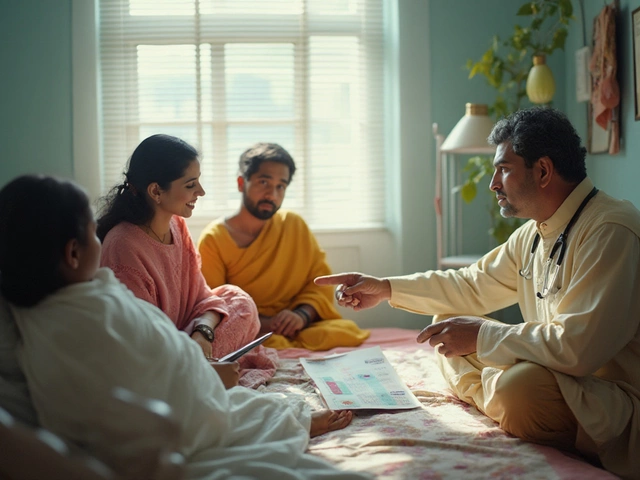Picture this: you’ve started an Ayurvedic routine, swapping mega-doses of painkillers for spoonfuls of chyawanprash or waking up to bitter kashayam instead of coffee. A week goes by. Then another. You start to wonder: is this slow but steady thing even working, or are you just becoming really good at eating things your grandma would love? It’s the question that drives everyone dipping their toes into Ayurveda—how long until you actually see a difference?
The Science and Philosophy Behind Ayurvedic Timelines
Ayurveda doesn’t hustle like Western medicine does. It’s not about blasting symptoms into oblivion—it’s more like nudging your body back into balance. That’s because Ayurveda treats your root imbalances, not just the headache, the cold, or the nagging stomach cramp. In India, a common saying among practitioners is, “Your disease didn’t show up overnight, so don’t expect it to vanish overnight either.” If you’re hoping for a one-pill wonder, Ayurveda will make you slow down. In fact, a 2019 survey by the Central Council for Research in Ayurvedic Sciences showed about 67% of patients felt moderate relief in the first two weeks, but real, stable changes happened after 60-90 days.
If you break a bone or spike a sudden, dangerous fever, Ayurveda actually often recommends fast-acting allopathy for emergencies. But for everything chronic—think digestion issues, hormonal swings, skin flare-ups, joint pain—Ayurveda wants to rebuild you layer by layer. It’ll use your digestion (agni), toxin levels (ama), and your body type (dosha constitution) to design the whole plan. There’s a commonly referenced Ayurvedic rule: for every year you’ve had a health problem, expect at least a month of disciplined Ayurveda to start turning it around. Notice that word—starting. The goal is usually stability and long-lasting relief, not just a tilt at the current symptoms.
Some people even feel subtle changes fast, like better sleep in a week or less bloating in 10 days. But if your psoriasis has been with you for ten years, don’t expect clear skin by Friday. And the quality of your results actually depends on how much effort you put in—are you following that food chart, skipping fast food, and actually taking your herbs, or just cherrypicking what’s easy? (My wife, Neha, is infamous for skipping her triphala powder and then acting surprised when her digestion is still off!)
| Health Issue | Average Duration for Noticeable Improvement (Ayurveda) | Notes |
|---|---|---|
| Acute Cold / Cough | 3-7 days | Quicker if started early and combined with diet changes |
| Chronic Indigestion | 1-2 months | Depends heavily on diet adherence |
| Skin Conditions (like Eczema, Psoriasis) | 3-6 months | Longer if the condition is older than 2 years |
| Joint Pain / Arthritis | 2-4 months | Panchakarma therapy can speed results |
| Anxiety / Sleep Issues | 2-6 weeks | Faster if lifestyle changes are incorporated |

What Can Affect Your Progress with Ayurveda?
No two people are going to heal at the same speed—even if they have the same symptoms. Why? Lots of reasons. Firstly, your body type (are you Vata, Pitta, or Kapha, or a mix?) plays a huge part. Vata folks often see results the quickest for stress and sleep issues but sometimes give up on routines too soon. Pitta types may see fast changes in digestion but slower results for stubborn inflammatory skin troubles. Kapha people sometimes need the longest, especially for weight or mucus-related complaints, but often get the most stable, long-term results if they stick with it.
Age matters, too. Kids respond to Ayurveda like magic because their bodies are quick to adapt—my little Anaya’s wheezing got better in about ten days with a strict regime of honey, tulsi, and warm water (plus total ban on junk food that nearly caused a meltdown during birthday week). Older adults usually need longer, partly because chronic degeneration takes years to accumulate, and clearing it out is not supposed to be rushed.
Lifestyle is the real game-changer, though. Ayurveda wasn’t designed to work all by itself with you sneaking in samosas twice a week. Classic Ayurvedic treatments expect you to stick to daily routines—timing of meals, exercise, sleep patterns, even how you brush your teeth. Sleep late, live on packaged snacks, miss doses—you’re stretching out your timeline by weeks or months. Here’s a tip: consistency really is king. Every pro-Ayurveda doctor I’ve met has one mantra—NO cheating, especially not with the big three triggers: fried food, irregular sleep, and too much screen time at night.
Diseases related to ama (toxins from undigested food), like swelling, allergies, or chronic headaches, won’t budge until you let the body naturally clear that build-up. This phase, sometimes called shodhana (cleansing), usually lasts two to four weeks for mild cases, but with more stubborn conditions, people often repeat cleansing every year for a while. And if you’ve been on regular prescription meds, your body may take longer adjusting to herbal medicines and shifting off synthetic drugs.
- Acute illnesses often respond in 3-7 days if therapies start early.
- Sub-acute or moderately chronic issues (like mild gastritis, early-stage migraines) – 3-8 weeks is normal.
- Long-term chronic problems (eczema, arthritis, hormonal disorders) – expect minimum 3-6 months, and sometimes a year or more, especially if periods of relapse are involved.
- Psychological or emotional problems—progress can be fast but depends strongly on lifestyle rituals (abhyanga, yoga, meditation) practiced along with medicines.
Believe it or not, the “healing crisis” is real. With Ayurveda, some people feel worse before feeling better—up to two weeks. This is often a sign that things are shifting internally: toxins leaving through the skin, loosening up digestion, mild flu-ish episodes. If you don’t panic and push through with your practitioner’s guidance, you usually come out stronger. That’s why traditional clinics always recommend ongoing follow-up sessions every two to four weeks, not just a single consult.

Maximizing Ayurveda Results: Simple Steps for Faster Healing
There’s no magic shortcut, but you can definitely help Ayurveda help you. First, see a qualified practitioner, not just YouTube videos or Insta-reels. It sounds obvious, but so many people try to guess herbs based on symptoms, not their dosha or current body state. A trained Ayurvedic doctor will dig into your pulse, tongue, and medical history. They might tweak your formula as you progress, which is way better than guessing your way through hair oils and syrups.
Then, follow up—don’t ghost your doctor after one week if you’re not seeing fireworks. Adjustments are normal, and a change in herbs or routines might be all you need. Also, give the *Ayurveda* plan at least two months before switching out of frustration (unless there’s a bad allergic reaction—those are rare, but yes, they happen sometimes with herbal mixes).
Food really does matter. A bowl of hot pongal can undo three days of herbal healing if your person’s plan requires avoiding rice or heavy carbs. Ayurveda is full of “what not to eat” lists for a reason. For example, most pitta-governed issues (think acne, ulcers) flare up with tomatoes and chillies. For vata, skip dry snacks and beans. And for kapha folks, dairy and sugar are the fastest way to undo months of hard work.
People always ask about supplements—should they add yoga, meditation, panchakarma, or stick to the medicines? The answer: yes to all, if you can. Panchakarma (deep body cleansing) isn’t needed for everyone, but it can cut months off the process for people with deep-rooted ama or chronic fatigue. Adding yoga and breathing exercises can speed up healing from both physical to mood disorders—a fact noted in a 2022 clinical trial from the All India Institute of Medical Sciences, where adding pranayama and meditation cut the usual time to see migraine relief through Ayurveda by nearly 40%.
- Stick to your diet chart religiously.
- Take your medicines at the prescribed hour (set reminders—you’d be surprised how easy it is to forget).
- Don’t skip on lifestyle rituals—self-massage (abhyanga), early rising, no screens late at night.
- Share minor setbacks with your practitioner ASAP so they can tweak the plan.
- Patience pays the biggest dividends. Most lasting changes sneak up on you gradually—you wake up one week and realize you’re sleeping better, eating normal foods, or moving without pain for the first time in months.
If you want something tangible, measure your progress—keep a diary of symptoms week-by-week (energy, pain, skin, digestion, mood). It helps you see real change and keeps your motivation up when things move at a snail’s pace. At our house, we have a “progress calendar” stuck to the fridge, where each of us ticks off how we’re doing with diet and sleep. It’s both grounding and, honestly, a little competitive (Neha usually wins at the sleep part—I take the trophy for sticking to herbal teas instead of coffee!).
Ayurveda asks you to partner with it, not just follow orders. Real, lasting results aren’t about a bottle of herbal pills—they’re about transforming your habits, routines, and even your mindset. The journey isn’t short, but for lots of people, it’s worth every week it takes. Progress, not perfection—trust me, patience and persistence go a long way, especially if your goal is deep, genuine health, not just a break from the latest symptom.





